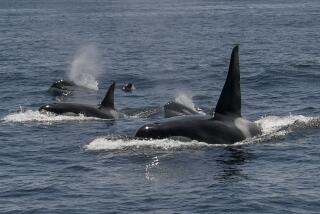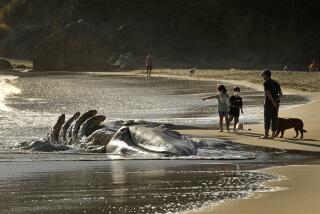End the killer whale circus
SeaWorld would no doubt prefer that the public forget about Dawn Brancheau, the trainer who died in an attack by a killer whale at its Orlando theme park more than three years ago. But that’s unlikely to happen in the near future — not after the recent release of the documentary “Blackfish,” which explores why Tilikum, a whale involved in two previous deaths, attacked Brancheau during a performance. Conclusions are hard to draw, but if nothing else, the public is learning to ask harder questions about whether it is humane or right to keep these intelligent, social marine mammals in aquarium tanks, performing for crowds.
The film, which opened to overwhelmingly positive reviews, traces Tilikum’s early life, when he was captured as a juvenile in the wild, his mother shrieking nearby, then kept in a second-rate whale park with a too-small pool and a cruelly undersized tank for securing the whales at night. He was one of three whales involved in the death of a trainer there before being moved to SeaWorld’s Florida park. The filmmaker interviews experts and former marine park trainers who have their own interpretations and regrets involving Tilikum in particular and killer whale shows generally. In the end, though, the reasons why Tilikum or any captive killer whale acts as it does are all conjecture, as are the claims by some trainers that they enjoyed a close bond with the whales. Maybe the humans feel the love, but who knows what’s going on in the mind of the whale, which might see the whole relationship as simply a front-flip-for-food transaction?
The subtext of the film is more important than whether SeaWorld trainers have enough expertise or whether Tilikum understood that he was killing Brancheau. We know far more about killer whales now than we did when the 1977 horror film “Orca” was released, in which a killer whale terrorizes a fishing village a la “Jaws.” Killer whales form close-knit, lifelong family groups, each group distinct in various ways from all others. They travel long distances in a day and are extremely intelligent. There are no known cases of a killer whale killing a human in the wild.
The public’s ability to view these creatures in SeaWorld-type attractions has probably contributed to our collective awe and appreciation, but that doesn’t make it right. Marine parks are not aquariums that exist to rescue and study animals in humane environments and to educate the public. They are high-profit water circuses, Cirque du Soleils in which the highly trained performers are intelligent ocean predators that have been forced into unnatural lives. Because there are only 45 captive whales worldwide — and new whales are almost never brought in from the wild — inbreeding is a real concern. India recently prohibited keeping dolphins in captivity, performing or not, declaring them by law to be “non-human people.” We wouldn’t necessarily go that far, but in the case of killer whales — which are actually the largest dolphins — it’s time for the circus to end.
More to Read
A cure for the common opinion
Get thought-provoking perspectives with our weekly newsletter.
You may occasionally receive promotional content from the Los Angeles Times.










